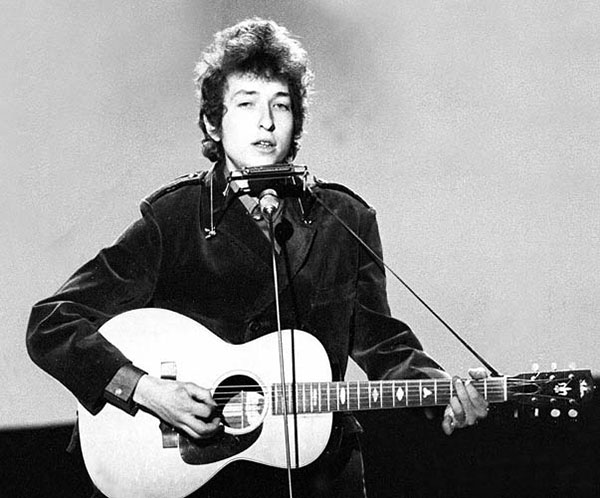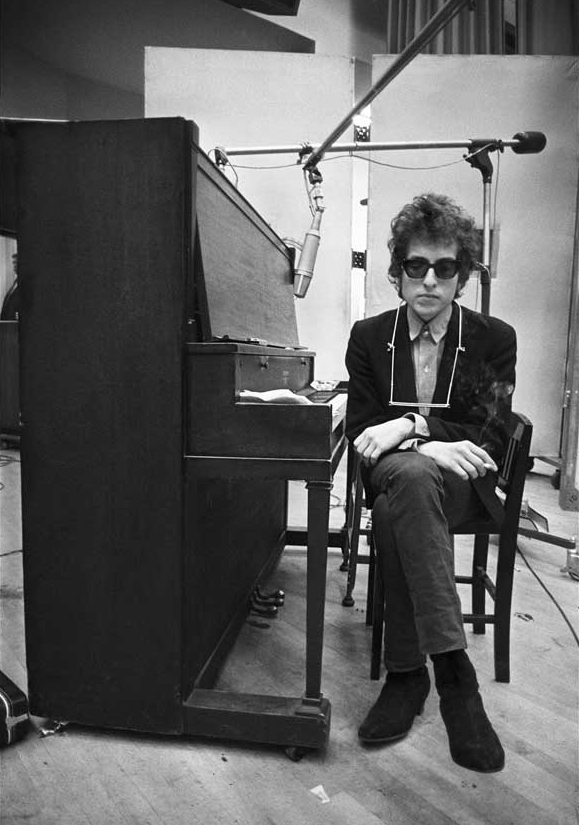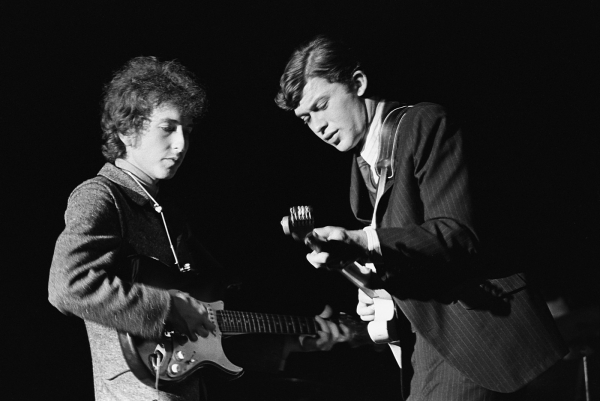EPIC 1965 NEWPORT FOLK FESTIVAL | BOB DYLAN PLUGS IN– FANS TUNE OUT?
 Before he went electric in 1965 — and drew jeers from legions of (arguably small-minded) fans in the process — Bob Dylan epitomized the hard-traveling folk troubadour, and he established this image largely on a vintage Gibson “Nick Lucas” model flat-top guitar. The young Dylan had played other Martin and Gibson models in the late ’50s and early ’60s, but in those final years of his acoustic era, before a “blonde on blonde” Fender Telecaster ushered in a whole new folk-rock sound, the “Nick Lucas” was his instrument of choice. He played this guitar in the studio and on tour from 1963 to ’66, and used it for the legendary albums Another Side of Bob Dylan and Bringing it All Back Home. And, although it didn’t appear on the covers of either of these, it is frequently seen in the many live performance tapes from the day, including broadcasts of the Newport Folk Festival in 1964 and ’65, and Dylan’s famous appearances on BBC TV in England in 1965. While, in hindsight, this Gibson “Nick Lucas” seems “just right” for the young Dylan, and has become an iconic folk guitar as a result, the model’s origins show that it is perhaps an unlikely choice for a scruffy young folky. Via * Back in 1963, Bob Dylan was the new darling and outspoken voice of political protest in America, performing songs seeking truth and justice– “Only a Pawn in Their Game”,“Who Killed Davey Moore?”, and most notably, “Blowin’ in the Wind”– backed by the Folk movement’s super-establishment including Pete Seeger, Joan Baez, the Freedom Singers, and Peter, Paul & Mary. But Dylan’s talent quickly proved too big to be boxed in by the narrow and idealistic parameters of Folk purists. By 1964 he’d already moved on musically– “Mr. Tambourine Man”, and “It Ain’t Me, Babe” showcased the emerging depth of his songwriting skills outside of protests and politics. Dylan’s fans worship him with a god-like fervor and frenzy. At the 1964 Newport Folk Festival, the enthusiastic crowd woos Dylan– cheering, chanting, and roaring for him to return to the stage at the end of his acoustic set. When he reappears on stage, it’s a love-fest. “I wanna say thank you, I love you”, says Dylan to the crowd. He can seemingly do no wrong. *  Bob Dylan At Piano During Recording Session, 1965. Bob Dylan in a contemplative mood, lost in thought behind his Ray-Bans, pausing for a break between takes at the upright piano at Studio A, Columbia Recording Studios in New York City during the sessions for “Highway 61 Revisited” in June 1965, a mere month before his electric set at the Newport Folk Festival would send Folk and Rock and Pop music into a whole new direction. –Photo by Jerry Schatzberg, Via * By the summer of ’65, Dylan’s stardom surpassed that of the Folk traditionalists at the Newport Folk Festival. Hundreds of adoring fans overwhelm Dylan’s car, as he basks in the attention, smiling and stating, “They’re all my friends.” But there is wave of rebellion beginning to well-up against Dylan among the so-called Folk purist fans. They see him as already being a sell-out, having moved over to the side of the establishment. In their eyes, Dylan is now just another cog in the wheel. The stage is now set for the epic event that will forever be remembered as– When Dylan Went Electric. So what inspired Dylan to go electric in the first place? Some say Dylan was inspired (or challenged perhaps) by an exchange he had with John Lennon. Dylan slammed Lennon, essentially dismissing The Beatles lyrically– “you guys have nothing to say”, was the message. Lennon’s counter was to enlighten Dylan of the fact that– he had no sound, man. Whether or not it resulted in Dylan going electric, or The Beatles writing more introspective lyrics, who knows– but it’s a helluva story. * Jerry Schatzberg’s shot of Bob Dylan in a New York studio. Unusual in that the singer is unguarded, and not posing for the camera – was taken in June 1965, during the recording of the Highway 61 Revisited album. Schatzberg was making his name as a fashion and portrait photographer when he got a call from Dylan’s then-girlfriend Sara Lowndes to say that if he wanted to take shots of the rising star and his newly acquired electric backing band, he was welcome. “Sara was a friend, and she and Nico [who later sang with the Velvet Underground] had been telling me about Dylan for a while,” remembers Schatzberg. “They took me down to see him play in the Village. After that, I was very keen to take his picture.” Schatzberg got to see a side of Dylan that was distinct from the one emerging in the public consciousness: he was playful, co-operative, and excited by the music he was making. “It was an ideal situation because he was absorbed by his work and he let me get on with mine. He was fun and willing to do anything, but he came across badly in the press at the time because the reporters’ questions didn’t match up with what he was thinking. I remember someone asked, ‘Do you believe in nature?’ His reply was, ‘I don’t believe in any drugs.’” The shot also coincided with Dylan’s denunciation by the folk world that had supported him. His performance at the 1965 Newport Folk Festival, with an electric guitar and backing band, had outraged the acoustic purists, and he followed it with a tour that mostly consisted of sustained boos from the audience. “I went to see him in concert at Forest Hills in New York, where he was booed,” remembers Schatzberg. “We went to (Dylan’s manager) Albert Grossman’s apartment in Gramercy Park afterwards, and Dylan was in a rage because he was absolutely sure of what he was doing. It’s not the job of an audience to tell an artist what they can and cannot do.” A few months after the Highway 61 sessions, Grossman commissioned Schatzberg to shoot the cover of “Blonde On Blonde”, Dylan’s next album. “We went to the meatpacking district of Manhattan and all I remember is that it was cold. Some frames were out of focus, Dylan picked one of them for the cover, and that was that. I don’t get a credit, but I did get paid.” * “Bob Dylan and Robbie Robertson. Knoxville, TN. Oct. 8, 1965″ –Image via The Robert Bolton Collection. 8, 1965″ * Dylan took the stage on Sunday with what was essentially the Paul Butterfield Blues Band– Mike Bloomfield on guitar, Sam Lay on drums, Jerome Arnold on bass, Al Kooper on organ, and Barry Goldberg on pian. They’d practiced with Dylan all Saturday night in a nearby mansion, but according to Kooper, “The Butterfield Band didn’t have the best chemistry to back Dylan… It (the practice) was a tough night… complicated and ugly”. Peter Yarrow introduced Dylan: “Ladies and gentlemen, the person that’s going to come up now has a limited amount of time … His name is Bob Dylan.” When Dylan and the band go into a loud, and raucous rendition of “Maggie’s Farm” the boos erupt almost immediately, along with mixed cheers. Then Dylan goes into “Like a Rolling Stone” (the week the song was released as a single) and the boos continue. After playing “Phantom Engineer” and still facing scorn from the crowd, Dylan tells the band, “Let’s go, man. That’s all”, and walks off stage– pissed and frustrated. A flustered Peter Yarrow returned to the microphone to try and calm things down, and along with Joan Baez manages to coax Dylan back on stage. Yarrow panders to the crowd by telling them Dylan is getting his acoustic guitar. Dylan is now ready to play for the crowd in an almost apologetic gesture– then there’s an awkward and tense appeal to the crowd for an E harmonica, followed finally by a classic Dylan rendition of “Mr. Tambourine Man” that gets things back on track for the folkies. It’s amazing to see Dylan do an about-face, reverting to acoustic, on a night when “going electric” was meant to be an epic artistic statement. And although the crowd exploded with applause at the end of Dylan’s forced acoustic set, he would not return to the Newport stage again for 37 years– and Ironically enough, the song they so fervently booed at Newport, “Like a Rolling Stone”, was named by none other than Rolling Stone magazine as the greatest rock song of all time. |

Comments
Post a Comment